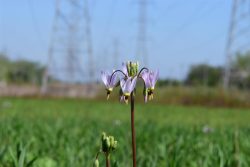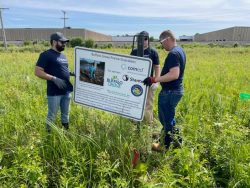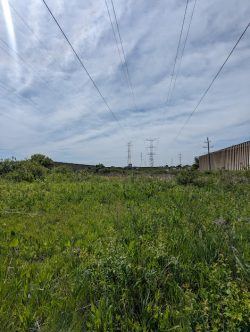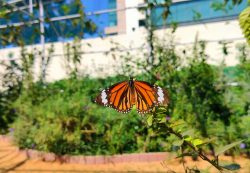Protecting Pollinators is ComEd’s Buzz: Saving Prairies One at a Time
June 18, 2024
As we celebrate Pollinator Week, it’s essential to recognize the vital role that pollinators play in our ecosystem. From bees and butterflies to birds and bats, these industrious creatures are responsible for pollinating flowering plants and crops worldwide – this is crucial for the reproduction of many of the plants we rely on for food. By transferring pollen from one flower to another, pollinators facilitate the production of fruits, vegetables, and nuts, which are essential components of our diet. Additionally, pollinators help maintain healthy ecosystems by supporting the growth of plants that provide habitat and food for other wildlife.
As one of the largest landowners in the state, ComEd is leveraging its footprint to strengthen and support the hard-working pollinators that help our communities thrive.
Buffalo Grove Prairie: A Hidden Gem
Prairies predate people in Illinois, but now they are rare and endangered ecosystems due to centuries of changing land use for development and farming.

One example of intact prairie is a 10-acres site in Buffalo Grove. This high-quality, remnant prairie, located beneath a ComEd transmission right-of-way—the corridors where transmission towers or distribution poles are located—is the last surviving piece of a natural area largely bulldozed decades ago. It stands as a testament to time and human development, offering a rare glimpse into the ecological history of Illinois.
“There aren’t many quite like it, which makes it a very special place” said Jeff Weiss, site land steward and leader of the Buffalo Grove Prairie Guardians. “It is a rare remnant that has not been plowed and it is the home to hundreds of rare and beautiful plants and animal species.”
Luckily, the presence of transmission towers and power lines kept land development at bay and saved this small prairie patch from destruction.
Over thirty years ago, ComEd recognized the ecological importance of this site and took the opportunity to step in and protect the land. Under the care of the Buffalo Grove Prairie Guardians (BGPG), a dedicated group of volunteer stewards, the prairie has flourished and is home to over more than three hundred different plant species, including many that provide food, pollen and nectar to pollinators, including the federally endangered rusty patched bumblebee—some that are federally threatened and endangered.
“ComEd has helped minimize vehicle access and limit construction in the area to make sure the Buffalo Grove prairie thrives. We are so thankful that ComEd has initiatives in place that help protect and restore prairies throughout northern Illinois,” said Jeff. “ComEd also assists with all aspects of BGPG coordination with their management, staff, and contractors. Their coordination efforts have been essential to success in managing Buffalo Grove Prairie.”
Most recently, 25 volunteers from ComEd helped clear out invasive plant species, remove debris and replace aging signage. They also helped install a new sign honoring Bev Hansen, who served as Buffalo Grove Prairie’s first land steward and oversaw restoration and maintenance efforts for nearly 30 years.

This hidden gem has become a source of inspiration for many, offering opportunities to connect with nature. Guided by Jeff, participants from community groups and various organizations can learn about native plants and the history of the site as they explore the trail-less prairie. These initiatives expose participants to elements that improve mental well-being and personal growth, which foster a deeper connection to nature and a sense of peace and relaxation.
ComEd Continues to Protect Sites Across Northern Illinois
 ComEd started its prairie program in 1994. Today, it actively restores and maintains over 500 acres of habitat in northern Illinois on its transmission right-of-ways. By spreading more than three million milkweed seeds and planting hundreds of acres of native prairie plants, ComEd is transforming these areas to benefit declining pollinator species.
ComEd started its prairie program in 1994. Today, it actively restores and maintains over 500 acres of habitat in northern Illinois on its transmission right-of-ways. By spreading more than three million milkweed seeds and planting hundreds of acres of native prairie plants, ComEd is transforming these areas to benefit declining pollinator species.
“ComEd is committed to creating and maintaining pollinator-friendly habitats,” said Lindsay Vacek, Senior Environmental Program Manager at ComEd. “Since 1994, we have restored and maintained over 500 acres of land covering 43 sites into prairie habitat. These initiatives provide essential food and shelter for bees, butterflies, and other pollinators.”
Additionally, the company supports pollinator projects through its Green Region grant program. Since the launch of the program in 2012, it has provided a total of $2.1 million in green space improvements for communities and organizations across northern Illinois.
Transforming Gardens into a Pollinator Paradise
Pollinator Week serves as an inspiration for action. Summer is a great time to create a pollinator garden in your backyard or in your neighborhood to contribute to a healthy and sustainable future for generations of both pollinators and people!
Here is a recipe for creating your own pollinator garden:
Necessary Ingredients:
- An area with soil
- As much sun as possible
- Plenty of water
- Rocks
- Mulch (straw, woodchip, or bark)
- Pollinator plants
- A ceramic bowl
- Long term commitment
Step 1. Preparation: Make sure your garden area is weed free and the soil is “loosened up.” Hint: Wet the soil the day before to make weed pulling easier! If need be, bring in fresh soil.
Step 2. Landscaping: If your garden site is very windy, a wind block may be necessary. Rocks are great for adding contrast to the garden and provide warm places for butterflies to perch. A bowl with mud in the garden gives butterflies a place to drink and obtain minerals—they need the mud to drink water, which they do through a process called “wicking”.
Step 3. Planting: Place plants far enough apart to allow for growth. Water thoroughly immediately after planting. Gardens with a high density of diverse plants are most attractive to pollinators.
Step 4. Mulching: Mulching is a great way to discourage weeds. First, place a 3-ply layer of wet newspaper on the ground around plants—the newspaper is optional, but acts as an extra biodegradable barrier against weeds—pile on a thick layer of mulch. When using paper, remember that it can help hold moisture in, but it will also necessitate more thorough watering to get water down to plant roots.
Step 5. Maintenance: Pruning: Take out dead plant material such as leaves, flowers or branches to allow for new growth. Make sure not to disturb bird nests, caterpillars, or chrysalis. Watering: New plants will need frequent water to establish strong roots. For established gardens, periodic deep waterings are a good idea, especially during the driest weeks of summer.

By creating pollinator-friendly gardens in our communities, we can collectively make a positive impact on pollinators and all who depend on them.
